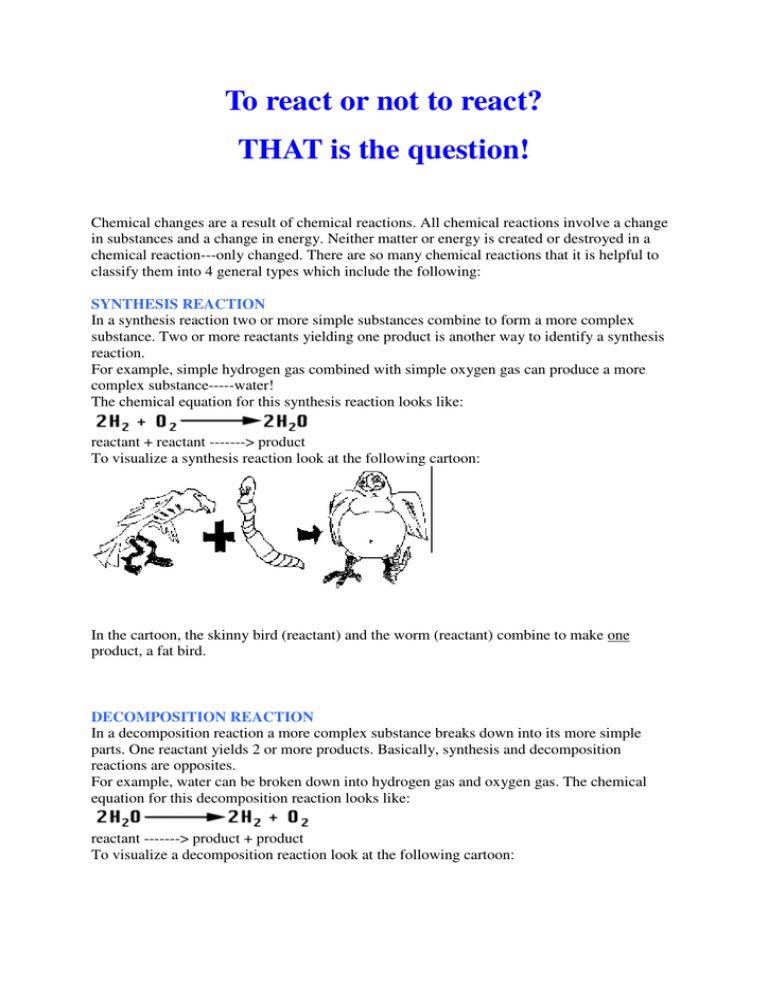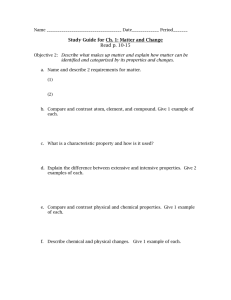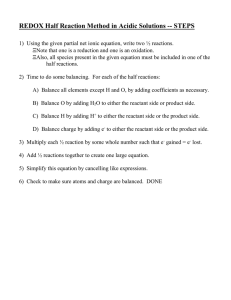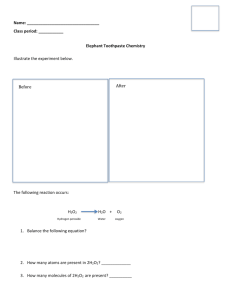To react or not to react? THAT is the question!
advertisement

To react or not to react? THAT is the question! Chemical changes are a result of chemical reactions. All chemical reactions involve a change in substances and a change in energy. Neither matter or energy is created or destroyed in a chemical reaction---only changed. There are so many chemical reactions that it is helpful to classify them into 4 general types which include the following: SYNTHESIS REACTION In a synthesis reaction two or more simple substances combine to form a more complex substance. Two or more reactants yielding one product is another way to identify a synthesis reaction. For example, simple hydrogen gas combined with simple oxygen gas can produce a more complex substance-----water! The chemical equation for this synthesis reaction looks like: reactant + reactant -------> product To visualize a synthesis reaction look at the following cartoon: In the cartoon, the skinny bird (reactant) and the worm (reactant) combine to make one product, a fat bird. DECOMPOSITION REACTION In a decomposition reaction a more complex substance breaks down into its more simple parts. One reactant yields 2 or more products. Basically, synthesis and decomposition reactions are opposites. For example, water can be broken down into hydrogen gas and oxygen gas. The chemical equation for this decomposition reaction looks like: reactant -------> product + product To visualize a decomposition reaction look at the following cartoon: In this cartoon the egg (the reactant), which contained the turtle at one time, now has opened and the turtle (product) and egg shell (product) are now two separate substances. SINGLE REPLACEMENT REACTION In a single replacement reaction a single uncombined element replaces another in a compound. Two reactants yield two products. For example when zinc combines with hydrochloric acid, the zinc replaces hydrogen. The chemical equation for this single replacement reaction looks like: reactant + reactant ---------> product + product To visualize a single replacement reaction look at the following cartoon: Notice, the guy in the orange shirt steals the date of the other guy. So, a part of one of the reactants trades places and is in a different place among the products. DOUBLE REPLACEMENT REACTION In a double replacement reaction parts of two compounds switch places to form two new compounds. Two reactants yield two products. For example when silver nitrate combines with sodium chloride, two new compounds--silver chloride and sodium nitrate are formed because the sodium and silver switched places. The chemical equation for this double replacement reaction looks like: reactant + reactant ---------> product + product To visualize a double replacement reaction look at the following cartoon: ENERGY OF CHEMICAL REACTIONS Chemical reactions always involve a change in energy. Energy is neither created or destroyed. Energy is absorbed or released in chemical reactions. Chemical reactions can be described as endothermic or exothermic reactions. Endothermic Reactions Chemical reactions in which energy is absorbed are endothermic. Energy is required for the reaction to occur. The energy absorbed is often heat energy or electrical energy. Adding electrical energy to metal oxides can separate them into the pure metal and oxygen. Adding electrical energy to sodium chloride can cause the table salt to break into its original sodium and chlorine parts. Exothermic Reactions Chemical reactions in which energy is released are exothermic. The energy that is released was originally stored in the chemical bonds of the reactants. Often the heat given off causes the product(s) to feel hot. Any reaction that involves combustion (burning) is an exothermic chemical reaction.






